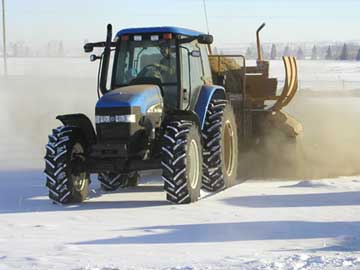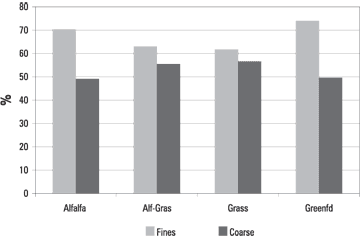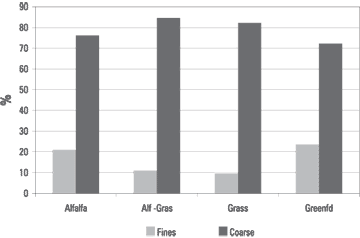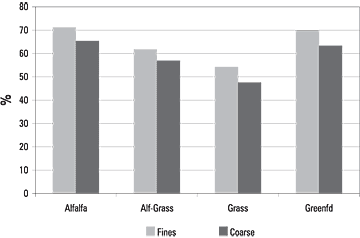| | Materials and methods | Dry hay results | Bale silage results | Conclusion
Round bale processors are commonly used for feeding beef cattle over winter. Feeds with a higher proportion of fines after processing may be more susceptible to higher dry matter and nutrient losses due to trampling. This factor raises the question: what is the effect of processing on particle size distribution in the windrow and potential feeding losses?
To answer this question, a study was designed by Alberta Agriculture and Food and Agriculture Technology Center specialists to measure the effect of bale processing on particle size distribution in the windrow. Both dry hay and silage round bales were evaluated, and the findings indicate that bale processing will affect the feed.
Materials and Methods
A bale processor with a large diameter closed drum rotor with flail hammers was used. Two smaller rotors with angled plates assisted bale feeding into the rotor. Material processing rate and cutting length were controlled by an adjustable hoop grate, which varied the flail exposure available to grab the material. A lower flail exposure results in slower processing and shorter material cut length. The unit had deflectors to direct processed material into a windrow.
Half inch and 2 inch flail depth settings were used on each dry hay type to measure the effect of the flail setting on particle size in the windrow. Based on manufacturers’ recommendations, only a half inch flail depth setting was used with each silage bale type.
Four feed types were selected for the project: alfalfa, alfalfa-grass, grass and cereal greenfeed. Oat greenfeed was utilized in the dry hay project and barley greenfeed for the silage project.
Procedure
- Each dry hay and silage feed type was tested for nutrient quality before processing.
- Four samples from each feed type and each flail setting were collected in large tubs placed on the ground. The exterior weathered portion of the bales was excluded from the samples.
- Each sample was weighed before sieving. A 3/4 inch screen was used to separate fine and coarse material. The fine and coarse samples were weighed to calculate their percentages of the original sample weight.
- Feed analysis samples were collected from the fines and coarse material for each feed type and flail setting.
- This process was repeated with three bales of each hay and silage type.
Dry Hay Results
Feed type significantly affected the percentage of fines versus coarse material in the windrow. Flail settings had no effect. As shown in Figure 1, processing had a greater effect on alfalfa hay than on the other three hay types.
Feed analysis reports indicated the fine material had higher concentrations of energy, protein and minerals than the coarse material. The coarse material had higher fiber content, therefore lower total digestible nutrients (TDN), as shown in Figure 2.

Figure 1. Per cent fines versus coarse by feed type – average of 1/2 inch and 2 inch flail settings

Figure 2. Per cent TDN in fines and coarse material – average of 1/2 inch and 2 inch flail settings
Bale Silage Results
Feed type did affect the percentage of fine versus coarse material in the windrow. As shown in Figure 3, the 1/2 inch flail setting had a greater effect on both the alfalfa and greenfeed bale silage than on the other two feed types.
Feed analysis reports indicated the fine material had higher concentrations of energy, protein and minerals than the coarse material. The coarse material had higher fiber content, therefore lower total digestible nutrients (TDN), as shown in Figure 4.

Figure 3. Per cent fines versus coarse by feed type at 1/2 inch flail setting

Figure 4. Per cent TDN in fines and coarse material at 1/2 inch flail setting
Conclusion
The results from this project did demonstrate that both hay and silage bales can be affected by bale processing. Feed types did influence the percentage of fines versus coarse material in the windrow.
Processing had the greatest effect on alfalfa or greenfeed in terms of the percentage of fines. Greenfeeds harvested beyond the mid-dough stage may have more grain shelling, leading to higher grain content in the fines. Legume-based hays with high leaf content will also generate more nutrient-dense fines. Feed analysis results reflected this shift with generally a higher level of crude protein, energy and minerals in the fines versus the coarse material.
Field observations indicated that the fines accumulated in the bottom of the row when processing dry hay. With bale silage, fewer fines were produced with less accumulation in the bottom of the row. Feeds with a higher level of fines after processing may be more susceptible to losses when feeding on the ground or on snow. The loss of fines during feeding may result in livestock not meeting their nutrient requirements for protein, energy or minerals even though initial feed tests showed adequate nutrient levels.
Summary
Livestock producers should be aware of the effect that bale processors may have on different feed types. Steps maybe required to manage the feeding program to help minimize potential feeding losses. Feeding systems such as bunks, tubs or fence line feeders should be considered to help reduce both feed quantity and quality losses, especially when feeding cereal greenfeed or legume hay feed types.
Acknowledgements
Support to complete this project was provided by:
- Gordon Hutton – Alberta Agriculture and Food
- Pat Ramsey – Alberta Agriculture and Food
- Blaine Metzger – Alberta Agriculture and Food, Agriculture Technology Center
- Technology Support Staff – Alberta Agriculture and Food, Agriculture Technology Center
Funding was provided by Alberta Agriculture and Food
For more information about the content of this document, contact Gordon Hutton, Alberta Agriculture and Food, Ag-Info Centre, telephone toll-free 310-FARM (3276).
Source: Agdex 420/57-2. September 2007. |
|